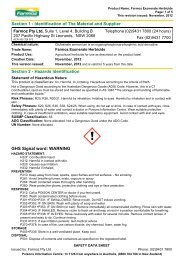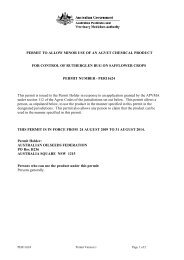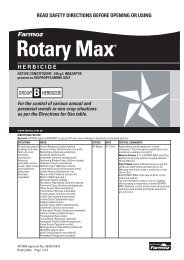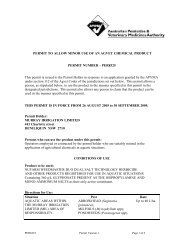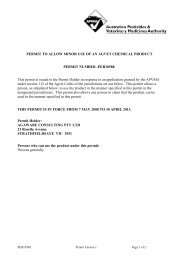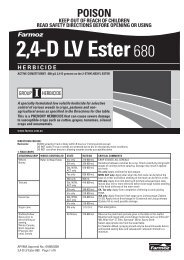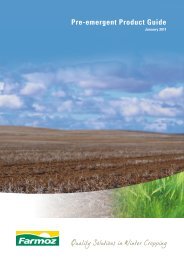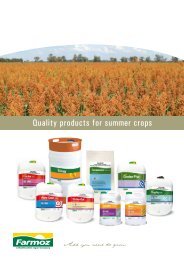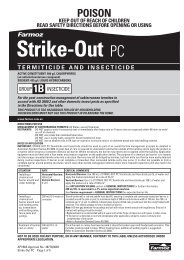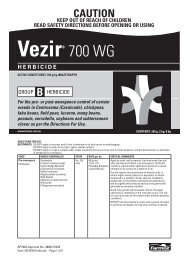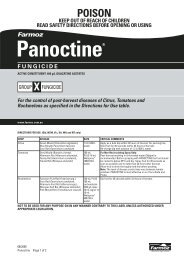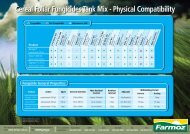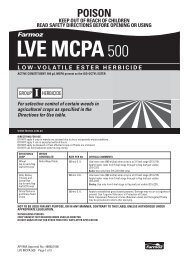Create successful ePaper yourself
Turn your PDF publications into a flip-book with our unique Google optimized e-Paper software.
<strong>Aphidex</strong>®<br />
APHICIDE<br />
For the control of certain Aphids on crops and<br />
pastures as specified in the Directions for Use<br />
table.<br />
www.farmoz.com.au<br />
POISON<br />
KEEP OUT OF REACH OF CHILDREN<br />
READ SAFETY DIRECTIONS BEFORE OPENING OR USING<br />
ACTIVE CONSTITUENT: 500 g/kg PIRIMICARB<br />
(an anti-cholinesterase compound)<br />
GROUP 1A INSECTICIDE<br />
DIRECTIONS FOR USE:<br />
Restraints: DO NOT apply from the air when the crosswind is less than 3 km/hr.<br />
1. FRUIT CROPS – TREE AND VINE CROPS<br />
RATE<br />
In the following table:<br />
“Fruit Crops – Tree and Vine Crops” all rates given are for dilute spraying.<br />
For concentrate spraying, refer to Mixing/Application section.<br />
CROP PEST STATE RATE<br />
WHP CRITICAL COMMENTS<br />
Apples Woolly Aphid NSW, ACT, Vic,<br />
Tas, SA, WA,<br />
only<br />
Citrus Citrus Aphid NSW, ACT, Vic,<br />
Tas, SA, WA,<br />
only<br />
APVMA Approval No.: 61595/0609<br />
<strong>Aphidex</strong> <strong>WG</strong> Page 1 of 5<br />
Per Per<br />
100 L ha<br />
50 g 1.1-1.7<br />
kg<br />
<strong>WG</strong><br />
CRITICAL COMMENTS<br />
For all uses in this table “Fruit Crops” – Tree and Vine Crops”:<br />
Apply by dilute or concentrate spraying equipment. Apply the same<br />
total amount of product to the target crop whether applying this<br />
product by dilute or concentrate spraying methods.<br />
2 days Use the higher rate when less than 2200 L of spray<br />
per ha. Add 18 mL Wetspray 600 per 100 L.<br />
50 g 1.1 kg Apply when aphids appear. Use at least 2200 L spray<br />
per ha.<br />
Aphids Qld, WA only 2.5 g – Apply only where pest management is being<br />
implemented and only when it is apparent that<br />
parasite predators will not control the infestation<br />
within a reasonable time.<br />
Stone Fruit Black Peach All States 50 g 1.1 kg Apply at pink bud or when aphids appear. Use at<br />
Aphid, Green<br />
Peach Aphid,<br />
Cherry Aphid<br />
least 1100 L spray/ha.<br />
2. FRUIT CROPS – NON TREE AND VINE CROPS<br />
CROP PEST STATE RATE WHP CRITICAL COMMENTS<br />
Per Per<br />
100 L ha<br />
Blueberries<br />
Pepinos<br />
Aphids Qld, WA only 50 g – 2 days –<br />
Strawberries Qld, NSW, 35 g Thorough coverage is necessary. If used in<br />
ACT, WA, only<br />
conjunction with predatory mites, apply before<br />
release or only after mites have fully established<br />
within the crop.
3. VEGETABLES<br />
CROP PEST STATE RATE WHP CRITICAL COMMENTS<br />
Per Per<br />
100 L ha<br />
Artichokes<br />
(globe)<br />
Asparagus<br />
Aphids All States 50 g – 2 days –<br />
Beetroot Green Peach<br />
– 1 kg Use at least 500 L spray/ha plus 18 mL/100 L<br />
Aphid<br />
Wetspray 600.<br />
Beans Cowpea Aphid Vic, Tas,<br />
500 g Apply as beans emerge and thereafter whilst aphid<br />
(Aphis craccivora) WA only<br />
attack continues. Spray thoroughly.<br />
Aphids All States 50 g –<br />
Broad beans,<br />
Lima beans<br />
Broccoli,<br />
Brussels<br />
Sprouts,<br />
Cabbages,<br />
Cauliflowers<br />
Brussels<br />
Sprouts,<br />
Cabbages,<br />
Cauliflowers<br />
Chinese<br />
cabbages<br />
Capsicums Aphids<br />
All States Spray when aphids are detected and repeat as<br />
necessary. Use the higher rates if applied in<br />
conditions below 20°C.<br />
Cucurbits Apply every 5-10 days during periods of rapid plant<br />
growth to delay virus buildup. Use the higher rates if<br />
applied in conditions below 20°C.<br />
Endive,<br />
Garden Cress<br />
All States 50 g – –<br />
Kale Cabbage Aphid,<br />
Green Peach<br />
Aphid<br />
<strong>Aphidex</strong> <strong>WG</strong> Page 2 of 5<br />
Cabbage Aphid All States 100-<br />
200 g<br />
Green Peach<br />
Aphid<br />
Cabbage Aphid,<br />
Green Peach<br />
Aphid<br />
All States 100-<br />
200 g<br />
Potatoes Potato Aphid All States 250-<br />
500 g<br />
500 g or<br />
1 kg<br />
500 g-<br />
1 kg<br />
500 g or<br />
1 kg<br />
Apply every 10-14 days commencing 1 week after<br />
planting. Use 500 L spray per ha.<br />
Add 18 mL Wetspray 600 per 100 L.<br />
If lower spray volumes per ha are used, increase<br />
the rate per 100 L to maintain the equivalent rate of<br />
product per ha.<br />
Use the higher rate if temperature falls below 20°C.<br />
Apply every 10-14 days commencing 1 week after<br />
planting. Use 500 L spray per ha.<br />
Add 18 mL Wetspray 600 per 100 L. If lower spray<br />
volumes per ha are used, increase the rate per 100 L<br />
to maintain the equivalent rate of product per ha.<br />
Use the higher rate if temperatures falls below 20°C.<br />
Kiwano Aphids All States Apply every 5-10 days during periods of rapid plant<br />
growth to delay virus buildup.<br />
Leeks 50 g – –<br />
Lettuce All States 100-<br />
200 g<br />
500 g-<br />
1 kg<br />
Spray when aphids are detected and repeat if<br />
necessary. Use the higher rates if applied in<br />
conditions below 20°C.<br />
Okra All States 50 g – For use in IPM programmes where Helicoverpa<br />
resistance strategy is being practiced.<br />
Peas All States 100- 500 g-<br />
–<br />
200 g 1 kg<br />
Radishes Cabbage Aphid,<br />
Green Peach<br />
Aphid<br />
Shallots,<br />
Spinach<br />
Swedes,<br />
Turnips<br />
All States 100-<br />
200 g<br />
All States<br />
NSW only Spray when aphids are detected and repeat if<br />
All States 100-<br />
200 g<br />
500 g-<br />
1 kg<br />
500 g-<br />
1 kg<br />
Aphids 50 g – –<br />
Cabbage Aphid,<br />
Green Peach<br />
Aphid<br />
All States 100-<br />
200 g<br />
500 g-<br />
1 kg<br />
necessary. Use the higher rate if applied in<br />
conditions below 20°C.<br />
Apply in 200 L spray per ha when aphids first appear.<br />
If higher spray volumes per ha are used, decrease<br />
the rate per 100 L to maintain the equivalent rate of<br />
product per ha.<br />
Use the higher rate if temperature falls below 20°C.<br />
Apply every 10-14 days commencing 1 week after<br />
planting. Use 500 L spray per ha.<br />
Add 18 mL Wetspray 600 per 100 L. If lower spray<br />
volumes per ha are used, increase the rate per 100 L<br />
to maintain the equivalent rate of product per ha.<br />
Use the higher rate if temperature falls below 20°C.<br />
Apply every 10-14 days commencing 1 week after<br />
planting. Use 500 L spray per ha.<br />
Add 18 mL Wetspray 600 per 100 L. If lower spray<br />
volumes per ha are used, increase the rate per 100 L<br />
to maintain the equivalent rate of product per ha.<br />
Use the higher rate if temperature falls below 20°C.<br />
Tomatoes Aphids All States Spray when aphids are detected and repeat if<br />
necessary. Use the higher rates if applied in<br />
conditions below 20°C.<br />
Watercress Aphids All States 50 g – –
4. ORNAMENTALS<br />
CROP PEST STATE RATE WHP CRITICAL COMMENTS<br />
Rose,<br />
Chrysanthemums<br />
Rose Aphid,<br />
Chrysanthemum<br />
Aphid<br />
<strong>Aphidex</strong> <strong>WG</strong> Page 3 of 5<br />
Per<br />
100 L<br />
Per<br />
ha<br />
All States 50 g 8 g/15 L<br />
knapsack<br />
– Apply when aphids appear. Spray to give complete<br />
coverage of plants.<br />
Ornamentals Aphids NSW, ACT,<br />
WA only<br />
–<br />
Qld, WA only 35 g – If applied in conjunction with predatory mites<br />
(Phytoseiulus persimilis) apply before release or<br />
only after mites have become fully established.<br />
DO NOT apply more than two (2) sprays in quick<br />
succession where IPM is practiced. Where roses<br />
are grown in dense hedges and IPM is used, spray<br />
on the upper half of the hedge where the aphids are<br />
attacking the buds. Allow the lower half of the<br />
hedge to serve as a refuge for P. persimilis. In such<br />
situations APHIDEX <strong>WG</strong> should NOT be mixed with a<br />
fungicide which requires very careful coverage.<br />
Note: Because of the wide range of crops and pests<br />
encompassed under Ornamentals, the phytotoxicity<br />
and efficacy of this compound cannot be<br />
guaranteed under all uses. Test the chemical for<br />
phytotoxicity on a small area of crop before<br />
widespread usage.<br />
5. BROADACRE CROPS<br />
CROP PEST STATE RATE WHP CRITICAL COMMENTS<br />
Canola Cabbage Aphid<br />
(Brevicoryne<br />
brassicae),<br />
Green Peach<br />
Aphid<br />
(Myzus persicae)<br />
Cotton Cotton Aphid<br />
(Aphis gossypii),<br />
Green Peach<br />
Aphid<br />
(Myzus persicae)<br />
Per<br />
100 L<br />
Duboisia Aphids Qld, WA only 50 g 1.1 kg – Apply when population warrants.<br />
Lucerne,<br />
Medic pastures<br />
Spotted Alfalfa<br />
Aphid,<br />
Blue Green Aphid<br />
Per<br />
ha<br />
All States – 500 g or<br />
1 kg<br />
NSW, Qld,<br />
WA only<br />
– 500 g or<br />
750 g<br />
Aerial<br />
Application<br />
Spray<br />
volume<br />
of 30-50<br />
L/ha<br />
Ground<br />
Application<br />
Spray<br />
volume<br />
of 100<br />
L/ha<br />
minimum<br />
All States – 100-150<br />
g in 200-<br />
300 L<br />
water<br />
14 days<br />
harvest/<br />
grazing<br />
21 days<br />
harvest/<br />
grazing<br />
3 days<br />
grazing<br />
Apply when aphids first appear using 30-100 L<br />
water/ha (ground rig) or 20-50 L/ha (aerial).<br />
Use higher rate if temperature falls below 20°C.<br />
Add 18 mL Wetspray 600 per 100 L spray.<br />
Thorough spray coverage is essential to produce<br />
best results.<br />
Stage 1: Apply when aphids exceed 90% of plants<br />
infested.<br />
Stage 2: Apply when aphids exceed 95% of plants<br />
infested.<br />
Stage 3: Apply when aphids exceed 50% of plants<br />
infested,or if 1% bolls are open and<br />
honeydew is present apply when aphids<br />
exceed 10% of plants infested.<br />
If a spray is required for another pest, the aphid<br />
threshold for each phase should be reduced by half<br />
to determine the need to spray for aphids; eg. 50%<br />
becomes 25% of plants infested.<br />
Use APHIDEX <strong>WG</strong> no more than twice per season.<br />
Adhere to the resistance management strategy and<br />
rotate chemistry.<br />
DO NOT use APHIDEX <strong>WG</strong> as consecutive sprays.<br />
Application: High rate to be used when there is a<br />
high aphid population density or with dense crop<br />
growth. Complete coverage and penetration of the<br />
crop is essential.<br />
Timing (Qld only): On seedling lucerne treatment<br />
is necessary when one or two aphids are present<br />
per plant. Established lucerne and medics (Spring<br />
and Summer) - spray when there are 20-40 aphids<br />
per stem.<br />
Spotted Alfalfa Aphid (SA, NSW, WA and Tas only):<br />
Apply when aphids begin to build up on stems and<br />
repeat as necessary.<br />
Spotted Alfalfa Aphid and Pea Aphid (Vic only):<br />
Seedling lucerne and medics - treat when 1-2<br />
aphids per plant are present.<br />
Established lucerne and medics (Spring and<br />
Summer) - spray when there are 20-40 aphids<br />
per stem.<br />
continued overleaf
5. BROADACRE CROPS – continued<br />
CROP PEST STATE RATE WHP CRITICAL COMMENTS<br />
Lucerne,<br />
Medic pastures<br />
Spotted Alfalfa<br />
Aphid,<br />
Blue Green Aphid<br />
Lupins Green Peach<br />
Aphid<br />
<strong>Aphidex</strong> <strong>WG</strong> Page 4 of 5<br />
NSW, ACT,<br />
Vic, WA only<br />
Cowpea Aphid NSW, ACT, Vic,<br />
WA only<br />
Green Peach<br />
Aphid<br />
Per<br />
100 L<br />
Per<br />
ha<br />
Lucerne Pea Aphid Vic, WA only – 100-<br />
150 g<br />
Winter Cereals Aphids<br />
(Rhopalosiphum<br />
maidis)<br />
Aphids<br />
(R.maidis,<br />
R.paddi)<br />
All States – 100-150<br />
g in 200-<br />
300 L<br />
water<br />
– 250 g<br />
3 days<br />
grazing<br />
6 weeks<br />
harvest/<br />
grazing<br />
Apply when aphids begin to build up on stems.<br />
Repeat as necessary. Use 200-300 L per ha.<br />
Use the higher rate when there is a high aphid<br />
population density or dense crop or when<br />
temperature falls below 20°C.<br />
Apply when aphids first appear using 20-100 L/ha<br />
(ground rig) or 4-15 L/ha (aerial).<br />
Repeat as necessary. If low relative humidity<br />
conditions prevail add 1% or 10% Summer Spray Oil<br />
(DC-Tron or Caltex) to spray solution for ground and<br />
aerial application respectively.<br />
Note: For best coverage and hence best results with<br />
aerial application, apply when a slight crosswind<br />
with a minimum speed of 3 km/hr is present.<br />
WA only 300 g Apply when aphids first appear. Good coverage of<br />
the infested area is essential. Apply in 30-100 L/ha<br />
for aerial application. Repeat as necessary.<br />
If low relative humidity conditions prevail add<br />
Summer Spray Oil to the mix.<br />
All States<br />
WA only<br />
– 150 g<br />
250 -<br />
300 g<br />
3 days<br />
grazing<br />
6 weeks<br />
harvest/<br />
grazing<br />
from previous page<br />
Tas only: A cold weather adapted species which<br />
may be found at most times of the year. Spraying<br />
should be carried out when aphids begin to increase<br />
and be repeated as necessary. For the control of<br />
both the above lucerne and medic pasture pests<br />
APHIDEX <strong>WG</strong> at the recommended rate should be<br />
applied in 200-300 L of water per ha. Complete<br />
coverage and penetration of the crop is essential.<br />
Blue Green Aphid: This aphid is cooler weather<br />
tolerant and will be found at all times of the year.<br />
Spraying should be carried out as aphids are<br />
observed. In some areas Spotted Alfalfa Aphid has<br />
developed tolerance to pirimicarb and in those<br />
areas APHIDEX <strong>WG</strong> will not give satisfactory<br />
control. However, apparent tolerance should not be<br />
confused with poor application.<br />
Consult your local FARMOZ or Department of<br />
Agriculture representative for local information.<br />
Apply when 20 or more aphids are present per tiller<br />
and when the crop is between emergence of last<br />
leaf and flowering stages.<br />
Use 20-100 L/ha (ground rig) or 4-15 L/ha (aerial).<br />
If low relative humidity conditions prevail add<br />
Summer Spray Oil as for lupins. Where there is<br />
concern for infection by Barley Yellow Dwarf Virus,<br />
spraying should be carried out as soon as aphids<br />
are located in the crop.<br />
NOT TO BE USED FOR ANY PURPOSE, OR IN ANY MANNER CONTRARY TO THIS LABEL, UNLESS AUTHORISED UNDER<br />
APPROPRIATE LEGISLATION.<br />
WITHHOLDING PERIODS:<br />
FRUIT, VEGETABLES: DO NOT HARVEST FOR 2 DAYS AFTER APPLICATION.<br />
CANOLA: DO NOT HARVEST, GRAZE OR CUT FOR STOCKFOOD FOR 14 DAYS AFTER APPLICATION.<br />
COTTON: DO NOT HARVEST, GRAZE OR CUT FOR STOCKFOOD FOR 21 DAYS AFTER APPLICATION.<br />
LUCERNE, MEDIC PASTURES: DO NOT HARVEST, GRAZE OR CUT FOR STOCKFOOD OR FEED TO POULTRY FOR 3 DAYS AFTER APPLICATION.<br />
LUPINS, WINTER CEREALS: DO NOT HARVEST, GRAZE OR CUT FOR STOCKFOOD OR FEED TO POULTRY FOR 6 WEEKS AFTER APPLICATION.
GENERAL INSTRUCTIONS<br />
MIXING<br />
Fill tank 50 to 75% full then start agitation. Slowly pour granules into<br />
tank and maintain agitation throughout spraying.<br />
DO NOT pre-mix APHIDEX <strong>WG</strong> granules.<br />
APPLICATION<br />
If this product is applied when the temperature is less than 15°C it is<br />
essential to have thorough spray coverage for quick and total aphid<br />
control.<br />
Fruit Crops – Tree and Vine Crops:<br />
Dilute Spraying<br />
Use a sprayer designed to apply high volumes of water up to the point<br />
of run-off and matched to the crop being sprayed. Set up and operate<br />
the sprayer to achieve even coverage throughout the crop canopy.<br />
Apply sufficient water to cover the crop to the point of run-off. Avoid<br />
excessive run-off. The required water volume may be determined by<br />
applying different test volumes, using different settings on the sprayer,<br />
from industry guidelines or expert advice. Add the amount of product<br />
specified in the Directions For Use table for each 100 L of water. Spray<br />
to the point of run-off. The required dilute spray volume will change<br />
and the sprayer set up and operation may also need to be changed, as<br />
the crop grows.<br />
Concentrate Spraying<br />
Use a sprayer designed and set up for the concentrate spraying (that<br />
is a sprayer which applies water volumes less than those required to<br />
reach the point of run-off) and matched to the crop being sprayed. Set<br />
up and operate the sprayer to achieve even coverage throughout the<br />
crop canopy using your chosen water volume. Determine an<br />
appropriate dilute spray volume (See Dilute Spraying above) for the<br />
crop canopy. This is needed to calculate the concentrate mixing rate.<br />
The mixing rate for concentrate can then be calculated in the following<br />
way:<br />
EXAMPLE ONLY<br />
1. Dilute spray volume as determined above: For example 1500 L/ha.<br />
2. Your chosen concentrate spray volume: For example 500 L/ha.<br />
3. The concentration factor in this example is: 3x (ie 1500 L ÷ 500 L = 3).<br />
4. If the dilute label rate is 10 mL/100 L, then the concentrate rate<br />
becomes 3 x10, that is 30 mL/100 L of concentrate spraying.<br />
The chosen spray volume, amount of product per 100 L of water, and<br />
the sprayer set up and operation may need to be changed as the crop<br />
grows.<br />
For further information on concentrate spraying, users are advised to<br />
consult relevant industry guidelines, undertake appropriate<br />
competency training and follow industry Best Practices.<br />
COMPATIBILITY<br />
APHIDEX <strong>WG</strong> may be mixed in the spray vat with any one of the<br />
following products: Wetspray ® and Omite*. A mixture of APHIDEX <strong>WG</strong><br />
with more than one of these products or with any other product may<br />
be ineffective or may cause serious damage. The use of such a<br />
mixture is not recommended and would therefore be entirely at the<br />
user’s risk.<br />
RESISTANT WEEDS WARNING<br />
For insecticide resistance management<br />
FARMOZ APHIDEX ® <strong>WG</strong> Aphicide is a<br />
Group 1A insecticide. Some naturally occurring insect biotypes<br />
resistant to APHIDEX <strong>WG</strong> and other Group 1A insecticides may exist<br />
through normal genetic variability in any insect population. The<br />
resistant individuals can eventually dominate the insect population if<br />
APHIDEX <strong>WG</strong> or other Group 1A insecticides are used repeatedly. The<br />
effectiveness of APHIDEX <strong>WG</strong> on resistant individuals could be<br />
significantly reduced.<br />
Since occurrence of resistant individuals is difficult to detect prior to<br />
use FARMOZ Pty. Ltd. accepts no liability for any losses that may result<br />
from the failure of APHIDEX <strong>WG</strong> to control insects.<br />
APHIDEX <strong>WG</strong> may be subject to specific resistance management<br />
strategies. For further information contact your local supplier, FARMOZ<br />
representative or local agricultural department agronomist.<br />
RESISTANCE MANAGEMENT FOR GREEN PEACH APHID CONTROL<br />
Some Green Peach Aphids are resistant to all commonly used<br />
insecticides including APHIDEX <strong>WG</strong>. If resistance is known or<br />
suspected, do not use APHIDEX <strong>WG</strong> and seek advise on resistance<br />
management. If there is no APHIDEX <strong>WG</strong> resistance, use a maximum<br />
of 2 non-consecutive aphid sprays per season. If APHIDEX <strong>WG</strong> was<br />
used as the last aphid spray for the season, do not use it as the first<br />
aphid spray next season.<br />
PACK SIZES: 1 kg , 5kg<br />
<strong>Aphidex</strong> <strong>WG</strong> Page 5 of 5<br />
GROUP 1A INSECTICIDE<br />
PROTECTION OF LIVESTOCK<br />
Animals and poultry should be kept away from orchards and other<br />
treated areas during the horticultural spraying season.<br />
Keep animals and poultry away from spray and treated areas for a<br />
minimum of 3 days.<br />
PROTECTION OF WILDLIFE, FISH, CRUSTACEANS AND<br />
ENVIRONMENT<br />
DO NOT contaminate streams, rivers or waterways with this product or<br />
used containers.<br />
DO NOT apply under meteorological conditions (eg. crosswinds less<br />
than 3 km/hr) or from spraying equipment which could be expected to<br />
cause spray to drift onto adjacent areas, particularly wetlands,<br />
waterbodies or watercourses.<br />
STORAGE AND DISPOSAL<br />
Store in the closed original container in a dry, well-ventilated area, as<br />
cool as possible, out of direct sunlight. Store in a locked room or place<br />
away from children, animals, food, feedstuffs, seed and fertilisers.<br />
1kg: Triple or preferably pressure rinse containers before disposal.<br />
Add rinsings to spray tank. DO NOT dispose of undiluted chemicals onsite.<br />
If not recycling, break, crush, or puncture and bury empty<br />
containers in a local authority landfill. If no landfill is available, bury the<br />
containers below 500 mm in a disposal pit specifically marked and set<br />
up for this purpose clear of waterways, desirable vegetation and tree<br />
roots. Empty containers and product should not be burnt.<br />
5kg: Single rinse before disposal. Add rinsings to spray tank. DO NOT<br />
dispose of undiluted chemicals on-site. Puncture and bury empty<br />
containers in a local authority landfill. If no landfill is available, bury the<br />
containers below 500 mm in a disposal pit specifically marked and set<br />
up for this purpose clear of waterways, desirable vegetation and tree<br />
roots. Empty containers and product should not be burnt.<br />
SAFETY DIRECTIONS<br />
Product is poisonous if absorbed by skin contact, inhaled or<br />
swallowed. Repeated minor exposure may have a cumulative<br />
poisoning effect.<br />
When Mixing and Using<br />
Avoid contact with eyes and skin. DO NOT inhale dust or spray mist.<br />
When opening the container, preparing spray and using the prepared<br />
spray wear cotton overalls buttoned to the neck and wrist, or<br />
equivalent clothing, elbow-length PVC gloves, face shield or goggles. If<br />
product on skin, immediately wash area with soap and water.<br />
After use<br />
After use and before eating, drinking or smoking wash hands, arms<br />
and face thoroughly with soap and water. After each day’s use, wash<br />
gloves, face shield or goggles and contaminated clothing.<br />
FIRST AID<br />
If swallowed, splashed on skin or in eyes, or inhaled, contact a<br />
Poisons Information Centre (Phone eg Australia 131126; New Zealand<br />
0800 764 766) or a doctor at once. Remove any contaminated clothing<br />
and wash skin thoroughly. If swallowed, activated charcoal may be<br />
advised. Give atropine if instructed.<br />
MATERIAL SAFETY DATA SHEET<br />
Additional information is listed in the material safety data sheet<br />
(MSDS). A material safety data sheet for APHIDEX <strong>WG</strong> is available<br />
from FARMOZ on request. Call Customer Service on (02) 9431 7800.<br />
CONDITIONS OF SALE: The use of FARMOZ APHIDEX <strong>WG</strong> Aphicide being beyond the<br />
control of the manufacturer, no warranty expressed or implied is given by FARMOZ<br />
Pty. Ltd., regarding its suitability, fitness or efficiency for any purpose for which it is<br />
used by the buyer, whether in accordance with the directions or not and FARMOZ Pty.<br />
Ltd. accepts no responsibility for any consequence whatsoever from the use of this<br />
product.<br />
® Registered trademarks of FARMOZ Pty. Ltd.<br />
* Other registered trademarks<br />
UN 2757<br />
CARBAMATE PESTICIDES, SOLID, TOXIC, N.O.S.<br />
(CONTAINS PIRIMICARB)<br />
MARINE POLLUTANT<br />
HAZCHEM CODE: 2X<br />
PACKAGING GROUP: III<br />
6



